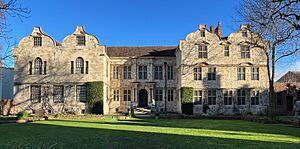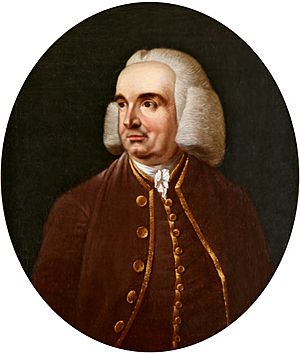Treasurer's House, York facts for kids

The building in 2023
|
|
| Location | Minster Yard, York, England |
|---|---|
| Type | Historic house museum |
| Founder | Frank Green |
| Architect | Temple Moore, others |
| Owner | National Trust |
| Public transit access | York Station |
|
Listed Building – Grade I
|
|
| Official name | Treasurer's House and attached garden walls, gate and gate piers |
| Designated | 14 June 1954 |
| Reference no. | 1257251 |
| Official name | York Minster cathedral precinct: including Bootham Bar and the length of City Walls extending round the precinct up to Monk Bar |
| Designated | 8 October 1937 |
| Reference no. | 1017777 |
The Treasurer's House in York, North Yorkshire, England, is a very old and special house. It is owned by the National Trust, a group that looks after historic places. They also take care of its beautiful garden. You can find it right next to York Minster, a famous cathedral.
Contents
History of the House
Early Days and Changes
The first Treasurer for York Minster was chosen in 1091. This person was in charge of the Minster's money. Not much is left of their first house. Some old walls and stones from the 12th century are still part of the current building. The Treasurer needed a grand home to welcome important guests.
This house was used by Treasurers until 1547. At that time, a big change called the English Reformation ended the Treasurer's job. The last Treasurer gave the house to the King. It was then sold to Archbishop Robert Holgate.
A Royal Visit and New Owners
Later, the Young family owned the house from 1561 to 1568. They rebuilt much of it into the house we see today. In the early 1600s, they added the balanced front. In 1617, King James I even visited the Treasurer's House! After the Young family, the house had many different owners. It was even split into smaller apartments.
Frank Green's Big Project
The house was brought back to its original grand state by Frank Green. He was a rich businessman from the area. Between 1897 and 1898, he bought all the different parts of the house. He hired Temple Moore, an architect, to restore it. This work was mostly finished by 1900.
In June 1900, Prince Albert Edward, Princess Alexandra of Denmark, and Princess Victoria visited the newly restored house. In 1930, Frank Green decided to move away from York. He gave the house and all its furniture to the National Trust. This was the first time a private home with its original contents was given to the Trust.
Roman Discoveries
The Treasurer's House was built right over an old Roman road. This road led out of Roman York to the north. During Frank Green's restoration work, four Roman column bases were found. One of these can still be seen in the cellar today.
Visiting Treasurer's House
The Treasurer's House is open to the public. You can buy a ticket to go inside. Members of the National Trust can enter for free. The garden and the Below Stairs Café are free for everyone to enjoy. Sometimes, you can even take special tours of the cellar and attic.
The Mystery of the Roman Soldiers

Many people say that ghosts haunt the Treasurer's House. One ghost is said to be George Aislaby, who owned the house in the 1600s. But the most famous haunting involves a group of Roman soldiers. People have seen them in the cellar.
Harry Martindale's Spooky Sighting
The first sighting was by a guest of Frank Green. Many years later, in 1953, an 18-year-old plumber named Harry Martindale was working in the cellar. He was fixing pipes for the National Trust. After working for about four hours, Harry heard a musical sound. It sounded like a trumpet playing the same notes over and over.
The sound got louder. Then, Harry saw a soldier appear from the wall, right below his ladder! The soldier wore a helmet with feathers. A cart horse followed, and then about nine or ten more Roman soldiers appeared in pairs. Harry was so scared that he fell off his ladder and hid in a corner.
What the Experts Found
The soldiers looked like legionaries, which were Roman foot soldiers. They were only visible from their knees up. They looked a bit messy. They carried round shields on their left arms. They also had daggers on their right side. Their tunics, or shirts, were green. When they reached the level of the old Roman road, Harry could see their sandals. These sandals had leather straps that went up to their knees.
Harry was so frightened that he didn't go back to work for several weeks. He told his story many times over the years. He never changed any of the details and never asked for money. Later, when people dug up parts of York, they found something amazing. Harry's descriptions of the soldiers' clothes matched those of Roman soldiers from the fourth century. These soldiers had taken over the Roman garrison (a military base) in York.
The Treasurer's House was even featured on the Discovery Channel TV show Ghosthunters.
See also
 In Spanish: Treasurer's House para niños
In Spanish: Treasurer's House para niños

